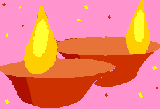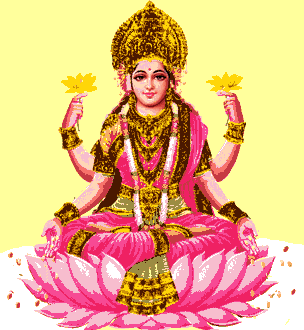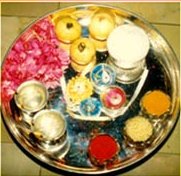Diwali - A Festival of Lights
 On this day people light up their houses and shops by lights which are
called "diya" as it is believed that Lord Rama had come back to
Ayodhya after defeating Ravana on this very day. This day commemorates the
victory of good over evil. This festival symbolises the unity in diversity
as every state celebrates in its own special ways. The celebration of the
four-day festival commences on Aswayuja Bahula Chaturdasi and would
conclude on Kartika Shudda Vijiya. On this day people light up their houses and shops by lights which are
called "diya" as it is believed that Lord Rama had come back to
Ayodhya after defeating Ravana on this very day. This day commemorates the
victory of good over evil. This festival symbolises the unity in diversity
as every state celebrates in its own special ways. The celebration of the
four-day festival commences on Aswayuja Bahula Chaturdasi and would
conclude on Kartika Shudda Vijiya.
First Day
The first day of the festival
Naraka Chaturdasi marks the
vanquishing of the demon Naraka by Lord Krishna and his wife Satyabhama.
According to puranas Naraka, the son of Bhudevi,acquired immense power as a
blessing from Lord Brahma after a severe penance. He soon unleashed a reign
of terror in the kingdom of Kamarupa, harassing the celestial beings with
his invincible might. Unable to bear the tyranny of the demon, the celestial
beings pleaded with Lord Krishna to save them from his torture. But Naraka
could not be easily killed as he had a boon that he could face death only at
the hands of his mother Bhudevi. So, Krishna asks his wife Satyabhama, the
reincarnation of Bhudevi, to be his charioteer in the battle with Naraka.
When Krishna feigns unconciousness after being hit by an arrow of Naraka,
Satyabhama takes the bow and aims the arrow at Naraka and kills him
instantly. Later Lord Krishna reminds her of the boon she had sought as
Bhudevi. The slaying of the Naraka by Sathyabhama could also be taken to
interpret that parents should not hesitate to punish their children when
they stray on to the wrong path. The message of Naraka Chaturdasi is that
the good of the society should always prevail over one's own personal bonds.
Second Day
 The second day is
Amavasya
when Lakshmi puja
is performed . On this day Goddess Lakshmi would be in her
benevolant mood and would fulfill all the wishes of her devotees. One
version says that it was on this day Goddess Lakshmi emerged from Kshira
Sagara when the Gods and demons were churning the sagara for Amrutha
Bhandam. Another version is that when Lord Vishnu in the guise of Vamana,
sought three feet of land from the very generous king Bali Chakravarthy,
Bali had to surrender his head as Vamana had conquered the earth and the
sky in His two strides. Lord Vishnu banishes Bali into the Pathala Loka
by keeping his third stride on Bali's head. Later, pleased by his
generosity, Lord Vishnu grants him a boon and he inturn requests the
Lord to guard his palace at Patha Loka. The second day is
Amavasya
when Lakshmi puja
is performed . On this day Goddess Lakshmi would be in her
benevolant mood and would fulfill all the wishes of her devotees. One
version says that it was on this day Goddess Lakshmi emerged from Kshira
Sagara when the Gods and demons were churning the sagara for Amrutha
Bhandam. Another version is that when Lord Vishnu in the guise of Vamana,
sought three feet of land from the very generous king Bali Chakravarthy,
Bali had to surrender his head as Vamana had conquered the earth and the
sky in His two strides. Lord Vishnu banishes Bali into the Pathala Loka
by keeping his third stride on Bali's head. Later, pleased by his
generosity, Lord Vishnu grants him a boon and he inturn requests the
Lord to guard his palace at Patha Loka.
Meanwhile, the Goddess is unable to bear the separation and her grief
affects the functioning of the entire universe. Brahma and Lord Shiva
offer themselves as guards and plead with Bali to relieve Vishnu. So, on
the Amavasya day Lord Vishnu returns to his abode and Goddess Lakshmi is
delighted. That is the reason it is believed that those who worship
Goddess Lakshmi on this day would be bestowed with all the riches.
Third Day
The third day is
"Kartika Shudda Padyami"
or "Pareva"
and it is only on this day that Bali would come out of Pathala
Loka and rule Bhuloka as per the boon given by Lord Vishnu. Hence, it is
also known as "Bali Padyami".
Fourth Day
 The fourth day is referred to as "Yama
Dvitiya" or "Bhaiya Dooij" it falls on Dooj, the
second day after the new moon. This day Yamaraj goes to his sister's
house who puts an auspicious mark on his forehead for his welfare.
Another version is after killing Narakasur, Lord Krishna, on his "Dooj
Day' goes to his sister Subhadra who welcomes him in the traditional way
by showing him a light and putting on his forehead a tilak of her
sisterly protection. Another myth behind this begins as when Bhagawaan
Mahavir found nirvana, his brother Raja Nandivardhan was distressed
because he missed him and was comforted by his sister Sudarshana. Since
then, women have been revered during this festival. This day all sisters
show their sisterly love for their brother by giving them their
traditional and loving welcome by putting this tilak on the forehead of
their brothers for their safety and well being. They are given gifts
from their brothers and held in the highest respect. The fourth day is referred to as "Yama
Dvitiya" or "Bhaiya Dooij" it falls on Dooj, the
second day after the new moon. This day Yamaraj goes to his sister's
house who puts an auspicious mark on his forehead for his welfare.
Another version is after killing Narakasur, Lord Krishna, on his "Dooj
Day' goes to his sister Subhadra who welcomes him in the traditional way
by showing him a light and putting on his forehead a tilak of her
sisterly protection. Another myth behind this begins as when Bhagawaan
Mahavir found nirvana, his brother Raja Nandivardhan was distressed
because he missed him and was comforted by his sister Sudarshana. Since
then, women have been revered during this festival. This day all sisters
show their sisterly love for their brother by giving them their
traditional and loving welcome by putting this tilak on the forehead of
their brothers for their safety and well being. They are given gifts
from their brothers and held in the highest respect.
However
 However, in the northern part of India Diwali is celebrated as the
return of Rama along with Sita and Lakshmana from his 14 years of exile
after killing Ravana. To commemorate his return to Ayodhya, his subjects
illuminated the kingdom and bursted crackers. For the Gujaratis,
Marwaris and other business community Diwali marks the worship of
Goddess Lakshmi and also the begining of the new financial year. However, in the northern part of India Diwali is celebrated as the
return of Rama along with Sita and Lakshmana from his 14 years of exile
after killing Ravana. To commemorate his return to Ayodhya, his subjects
illuminated the kingdom and bursted crackers. For the Gujaratis,
Marwaris and other business community Diwali marks the worship of
Goddess Lakshmi and also the begining of the new financial year.
|